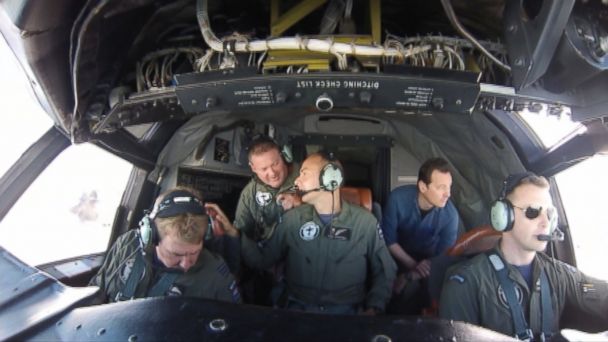In MH370 Search Objects Appear, Then Vanish in Roiling Waves
The P3-K2 Orion airplane was in the sky before the sun, taking off at dawn this morning in Perth Australia and quickly turning to the southwest.
Four hours and roughly 1,500 miles later the Royal New Zealand Air Force plane operated by Number 5 Squadron resumed the search for Malaysia 370.
The plane-call sign "Rescue 795?- was one of 12 military and civilian craft back in the air today after poor weather kept the fleet grounded the day before.

ABC News correspondent Clayton Sandell joins the Royal New Zealand Air Force in their search for the missing Malaysia Airlines plane. ABC News
Just a few minutes after Rescue 795 arrives in its assigned search area, the crew suddenly received new orders. The plane is told to continue flying to a new search area even farther from shore.
It's the same region where satellites recently spotted debris from space.
Squadron Leader Captain Brett McKenzie, co-pilot, Flight Lieutenant Dave Smith, and Flight Engineer Tony Strugnell make the necessary adjustments in the cockpit and change course.
When they arrive at the new search area, it doesn't take long to spot what looks like debris, large enough that a seagull has landed on top. The images are convincing, displayed on several black and white monitors around the plane.
Flight Lieutenant Stephan Graham races to his post at a large window on the left side of the plane.
"We just had a possible sighting. And we're turning around to try and find the object," Graham says.
The plane banks hard to the right, and G-forces make passengers feel three times their normal weight.
But the momentary excitement and adrenaline rush is short. After a few minutes, the crew determines the mysterious debris is actually a large, floating clump of seaweed.
It's a familiar drill for this team, which has put in more than 107 hours searching for Malaysia 370 since March 10. It will happen several more times on this flight: what appears to be a sizable object in the water turns out to be perfectly benign when the plane circles back for a close up view.
Just then, one of the plane's four engines shuts down, but on purpose. They crew wants to stay in the search area as long as possible. By shutting down an engine, they'll gain their mission an extra 20 minutes "on station," critical time they hope might help them find a trace of Malaysia 370.
"That would be pretty huge," Smith says, "because it would really be the first step in getting a lot of answers."
As the patrol starts to draw to a close for the day, another alert comes over the intercom.
"Mark! Mark! Mark! Light blue object. Port side," a crew member says. "Approximately two feet by two feet, partially submerged."
"It definitely was not seaweed," the voice says.
A bright dot appears on the computer map in the cockpit. The pilots steer a tight circle to investigate.
But by the time they get back to the spot, whatever the crew saw has vanished. They'll report the object sighting to the command center for follow up.
Rescue 795 is now running low on fuel. After a few quick calculations, the crew determines it has just enough gas for low fly-by of the Australian Navy ship the HMAS Success.
Then it's back to Perth. The flight lands 11 hours later, still no closer to knowing what happened to Malaysia 370 or the 239 people on board.
"We'd really like to be the ones to find it," says crewmember Deborah Haines.